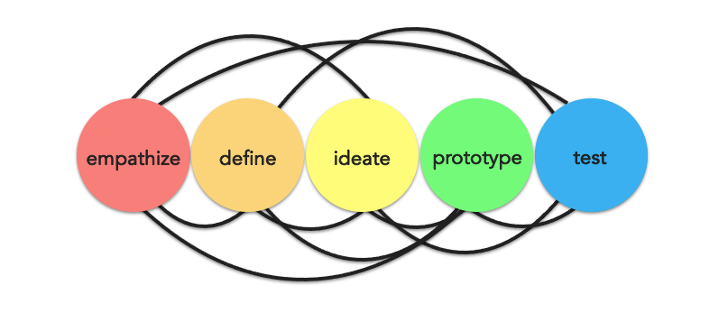What is Human-Centered Design (HCD) and Design Thinking?
Human-Centered Design (HCD) is a framework or mindset that emphasizes the human perspective, and there are many approaches and problem-solving processes that leverage an HCD framework; user-centered design, systems thinking, user experience design, trials of improved practices, design thinking, etc. In the Collaborative for Research On Women’s Nutrition (CROWN) Project we utilize and champion design thinking.
Design thinking is a human-centered problem-solving approach utilized by some of the most creative and innovative organizations globally. With emphases on research, ideation, iteration, prototyping, and multidisciplinary teams, Design Thinking helps practitioners leverage their creativity to achieve novel solutions to complex problems. The design thinking process includes five distinct, yet interconnected, steps—empathize, define, ideate, prototype, and test.

Empathize
Determine the stakeholders involved in the challenge of focus and learn about them. Empathy is at the core of the design thinking process, and during this phase the design team is tasked with gaining a comprehensive understanding of the related stakeholders, including, but not limited to, the target audience for whom they are designing. This can be done with a combination of primary and secondary research, with a strong emphasis on the primary.
Define
Clarify and further define the challenge of focus. During this phase, the design team is tasked with performing an analysis of the landscape of the challenge, which includes identifying the positives, challenges, and opportunities related to it, and ultimately identifying key insights that will serve as the basis for ideation.
Ideate
Brainstorm solutions for the identified challenge, rooted in a deep understanding of the end user(s) and related stakeholders. During this phase, the design team is tasked with using the data collected during the empathize and define phases to brainstorm creative, human-centered solutions for the challenge
Prototype
Create a low fidelity model of the selected solution. During this phase, the design team is tasked with selecting the top idea(s) from ideation to prototype. In design thinking, we emphasize low fidelity prototypes, or rough draft models, as that helps facilitate honest and useful feedback from users during the testing phase.
Test
Receive feedback on the prototype(s). In design thinking, the testing phase is done early and frequently, and the feedback received on the prototype is fed back into the design thinking process at whichever phase is most relevant.
While the process looks linear, it is designed to be iterative, and design teams are encouraged to flow through the different phases in the way that best responds to the insights, constraints, opportunities, and outcomes of their work. It is important to note that no two design thinking processes are identical. In order to be human-centered in the use of design thinking, each process must be tailored to the project’s specific context and related stakeholders.
When to use HCD
Have you heard that HCD and/or design thinking can only be used for product development? Well, that is not the case. The application of HCD and design thinking are much broader than that! In addition to product development, HCD and design thinking can be used to solve all types of challenges, including improving a system or process, and designing a new intervention or program. Before starting a design thinking process, the design team needs to identify the challenge of focus, which should be done in consultation with a diverse group of project stakeholders to ensure buy-in.
References
Stanford D.School. (2022). Tools for taking action. https://dschool.stanford.edu/resources
Johns Hopkins University Carey Business School. (2019, January 11). Innovation and human-centered design infographic. YouTube. https://www.youtube.com/watch?app=desktop&v=u5cyhI_1edU
